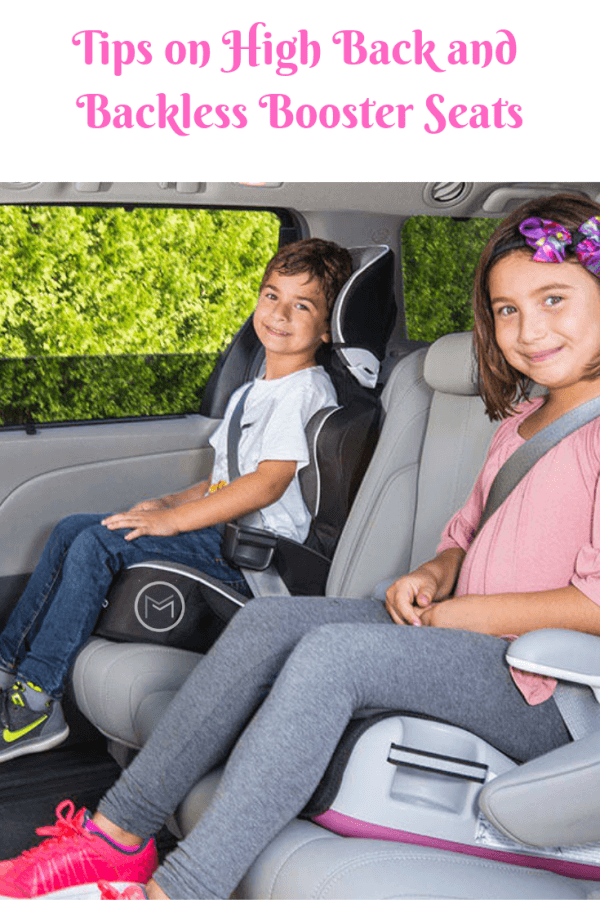Parents are often confused on buying high-back and backless boosters for their children. Besides the obvious, one booster has a back and one does not. And, the height and weight recommendations can be different also. Furthermore, all boosters are the next seat once your child exceeds the height and weight limits for front-facing car seats. Booster seats raise your child up on the vehicle seat. As a result, the seat belt will fit them properly. Today, we’re sharing parenting tips on purchasing high-back and backless booster seats for children.

It is essential to wait until your child is ready to upgrade from a forward-facing car seat to a booster seat. Waiting will ensure the safest situation if you ever get into an accident. According to healthychildren.org, your child has grown out of their forward-facing seat if they meet the following requirements:
- The child has outgrown the height and weight limits of the car seat
- The child’s shoulders are above the top harness slots of the seat
- The tops of the child’s ears reach the top of the seat
Once your child has outgrown their forward-facing car seat, decide which booster seat would be best for them. Here are the differences between high-back boosters and backless boosters:
High-back Booster Seats
The goal of the high-back booster seats are to boost your child high enough for the seat belt to fit across them properly. The upper back of these seats are used to provide extra protection for your child’s neck and back in the event of a car accident. Additionally, this type of booster seat is better for younger children who still need the extra support. High-back booster seats are usually combination car seats that can transform from a 5-point harness seat to a booster.
- This option is useful for vehicles that don’t have high seat backs or headrests.
- This booster-style is also suitable for younger children who fall asleep during car rides. It is more comfortable for them and provides extra support to keep them from slouching down in the seat.
- Some of these boosters have a seat belt guide to help the seat belt fit over your child better.
- Seats that convert to a high-back booster have the option to use the 5-point harness. This option keeps smaller children safer for a more extended time.
- Most models have cup holders attached.
- Most models are adequate for children weighing 30 or more pounds.

Backless Booster Seats
The backless booster is used to raise your child for the seat belt to fit correctly as well. However, it lacks the high back. So, it doesn’t give the extra head and neck support and protection for your child.
- This booster seat is suitable for older children who don’t need as much support.
- This option is useful for cars with high seatbacks and headrests.
- Some high-back boosters will convert to a backless booster when needed as your child grows.
- Most models have cup holders attached.
- Most models are adequate for children weighing 40 pounds or more and at least 35 inches tall.
- Parents also love this option because these seats are usually cheaper to purchase. Also, they are easy to move between vehicles when needed.
Booster Seat Safety
Both booster seat provide the extra safety your child needs. When your child outgrows their forward-facing car seat and meets the height and weight requirements, they are ready to upgrade. Read the booster seat manual for recommendations on the safest way to install the seat. Also, check the check the car seat laws in your state to be knowledgeable of which car seat your child is required to use. You can check your car seat laws at www.ghsa.org.
Some booster seats have a latch option to connect to your vehicle’s latch system. Other boosters are just secured to the chair with the seat belt as your child is seated in the booster. Your child should be tall enough with the booster seat that the shoulder belt rests across their shoulders and the lap belt rests across their laps.
Healthychildren.org recommends that children be at least 4 foot, 9 inches tall before they should switch out of a booster seat. Children can usually reach this height between the ages of 8 and 12, but in most cases, they will reach this height between the ages of 10 and 12.
When choosing which booster option is best for you and your family, you should consider what type of vehicle you have. Furthermore, consider what your backseat consists so you can provide the safest choice for your child. Unfortunately, if your backseat only has lap belts a booster seat will not be an option. Booster seats booster seats must provide your child with the chest belt they need. In this case, you will need to find a forward-facing car seat with a harness that will accommodate a higher weight limit. Or, you can look at options for installing chest belts into your car.
New Law Requiring Longer Use of Booster Seats
In Washington state, a new law will be put in place next year after Governor Jay Inslee signed House Bill 1012. This law states that children under the height of 4 foot, 9 inches must sit in a booster seat. So children between the ages of 10 and 12, will be required to use a booster seat until they reach the required height. Also, the seat belt must fit properly across their shoulder and their lap. If a driver is not following this rule, they will be pulled over and given a traffic citation.
According to CNN, Governor Jay Inslee signed this stricter car seat law to provide the safest possible way for children to ride in a vehicle. No other states have followed this exact pursuit yet, but 12 other states did update their car seat laws to require the use of rear-facing car seats for a more extended period. This new law will go in effect for Washington on January 1, 2020.
In Conclusion:
Upgrading to a booster seat is an exciting time for both parents and children. The seats are quickly transferable between vehicles and tend to take up less space than the average car seat. Choosing the right type of booster seat is very important, and you should consider your situation when making that decision. Many parents make the mistake of upgrading their child to a booster seat too soon or skipping the booster seat altogether, causing tragic consequences in the event of a car accident. Remember to read the manual of the booster seat for safety recommendations and also be knowledgeable on your state’s car seat laws. For more information on booster seat safety and tips, go to www.safekids.org.
You may also like: Educating Children About Safety
Arthur Bio:
 Keren Simanova is a busy mommy by day and a passionate writer by night. While spending countless hours researching car seats for her children, she created an educational car seat blog, CarSeatsMom.com to educate other mothers about the importance of car seats. Further, along the way, the blog became an invaluable source for research of a variety of car seat brands, unique features, and mommy reviews.
Keren Simanova is a busy mommy by day and a passionate writer by night. While spending countless hours researching car seats for her children, she created an educational car seat blog, CarSeatsMom.com to educate other mothers about the importance of car seats. Further, along the way, the blog became an invaluable source for research of a variety of car seat brands, unique features, and mommy reviews.




